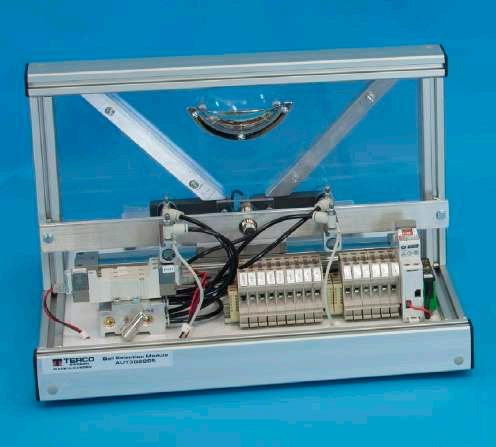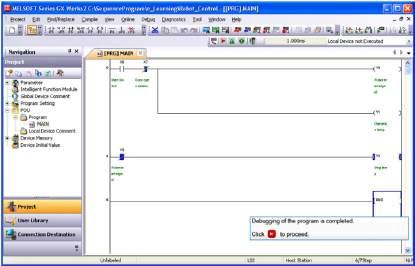
3 minute read
Control Techniques - PLC
from Terco Catalogue 2022
by terco-swe
The Basic Control Technology course offers a good ground training before more advanced courses in control technology and automation. The courses in this concept make use of a Laboratory Exercise Book.
The logic module for the Base Unit 2000 contains a logic block with switch and light diodes and various other relays.
Advertisement
The IDEC PLC board has 12 inputs and 8 outputs. Inputs and outputs of the PLC are connected to a 20 pin socket. The PLC is to be programmed by using the software Automatic Organizer.
The simplest PLC practices can be performed using a simulator board which shows the input status in the form of 6 LED´s and has output signals simulated by 8 on/off switches.
With the traffic lights module, pedestrian and vehicle control can be programmed. The cylinder module introduces pneumatics and sensors.
The ball selection module gives more training with pneumatics. Balls of metal and non-metal are taken from a storage area and sent to a selection station where the balls are detected by an optical sensor.
The laboratory package includes:
• Base Unit 2000
• Logic Module
• Software Automation Organizer
• PLC-Module
• Ball Selection Module
• Simulation Module
• Cylinder Module
• Terminal Block Module
• Traffic Lights Module
Technical Literature:
BOK312002 Basic PLC, Laboratory Exercises
ELE102000 Base Unit 2000
The starting point of this laboratory system is Base Unit 2000, a control panel and PCB-holder.

The Base Unit can be loaded with laboratory cards which have been carefully designed to suit each particular area of study.
The Lab Cards are placed in slots and are automatically powered via a D-sub connector.
General Data:
Supply voltage 220-240V 50-60Hz 1-phase.
The unit has 6 outputs with following data:
Outputs 1-3: DC 12V / 3A with LED indication and fuse.
Outputs 4-6: AC 24V / 3A with LED indication and fuse.
Dimension: 370 x 180 x 75 mm.
Weight: 4 kg
AUT302000 PLC Module

The PLC - Module has to be connected to the Base Unit 2000. To program a PLC a PC is connected to a programming port via a cable Alternatively a PC software may be used for programming.
The PLC-module contains a PLC-system with sockets to connect any chosen module card. For the sockets there are several switches to simulate faults at the different inand outputs.
General data
Mitsubishi Melsec FX3s DS PLC ( 24 V ) 8 inputs and 6 outputs
Input and output of the PLC is connected to a 20 pin socket
Dimensions: 240 x 140 x 55 mm
Weight: 0.5 kg
AUT302001 Simulation Module
The signal levels on the inputs can be altered through a simulation module, plugged into the sockets of the PLC module.
General data
Shows input status with 6 LED and has out-going signals simulated by 8 on/off switches.

Dimensions: 100 x 140 x 40 mm
Weight: 0.1 kg
AUT302002 Traffic Lights Module

The Traffic Lights Module is to be connected to the PLC Module.The Module simulates a traffic crossing for cars and pedestrians at a pedestrian crossing.
When experimenting with the Traffic Module, the student has the task of creating a PLC program to control the traffic lights.
There are red and green lights for the pedestrian crossing, and red, yellow and green for the vehicle traffic
Dimension: 100 x 140 x 40 mm
Weight: 0.1 kg
:
AUT302003 Cylinder Module
This module is used to study the actions and uses of electrically controlled valves.

General Data:
The module consists of two pneumatic cylinders, two electrically controlled valves and four sensors. The components are mounted on a metal panel. Compressed air (3-8bar) is required.

Dimension: 200 x 140 x 90 mm
Weight: 1 kg
AUT302004 Terminal Block Module

The Terminal Block Module is to be connected to the PLC-Module. The PLC-Module together with the the Terminal Block Module will be used for connections to the Ball Selection Module. The connections will be made with one wire to each output and input. In this case there will be 8 inputs and 6 outputs for control of the valves (for the cylinders), and sensors on the Ball Selection Module.
Connection between PLC and Lab Equipment
Dimension: 100 x 140 x 40 mm
Weight: 0.1 kg
AUT302005 Ball Selection Module
This module is used to select balls of different colour and material to two different stores. It includes store, collect position having a measurement fixture, two output positions and two stores.
On the board there is magnetic detection, inductive sensor and micro switch. The Ball Selection Module gives the student more advanced training in pneumatics. From a storage area, the balls of metal and non-metallic materials are sent down to a sorting station.
The arrival of the balls is detected by an optical sensor. The selection is made by a shuttle cylinder that carries the balls to the relevant container. A mini cylinder deposits the balls into the correct container. The Ball Selection Module is connected to the PLC board via the Terminal Block Module.
Dimension: 340 x 360 x 240 mm
Weight: 5.5 kg













